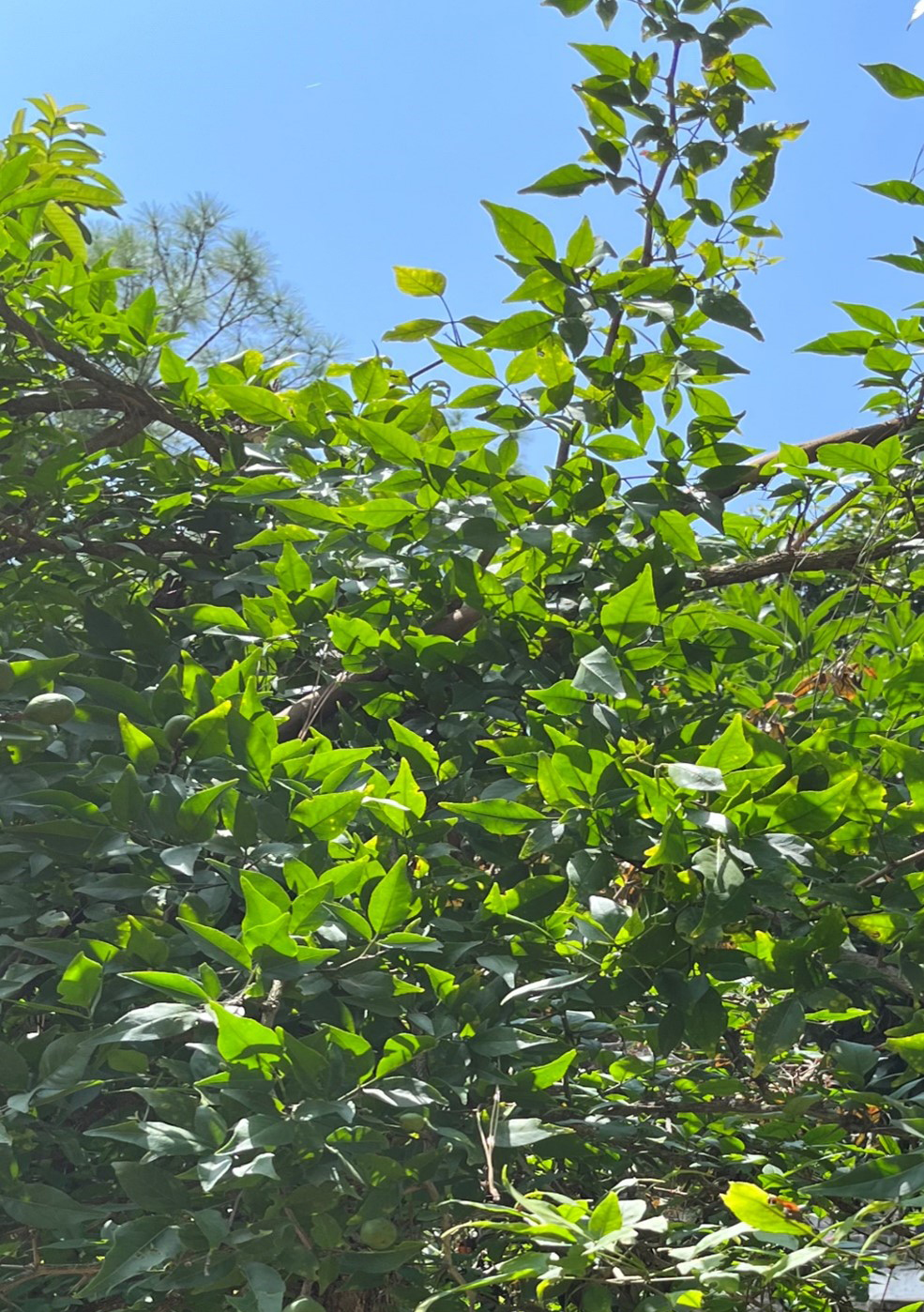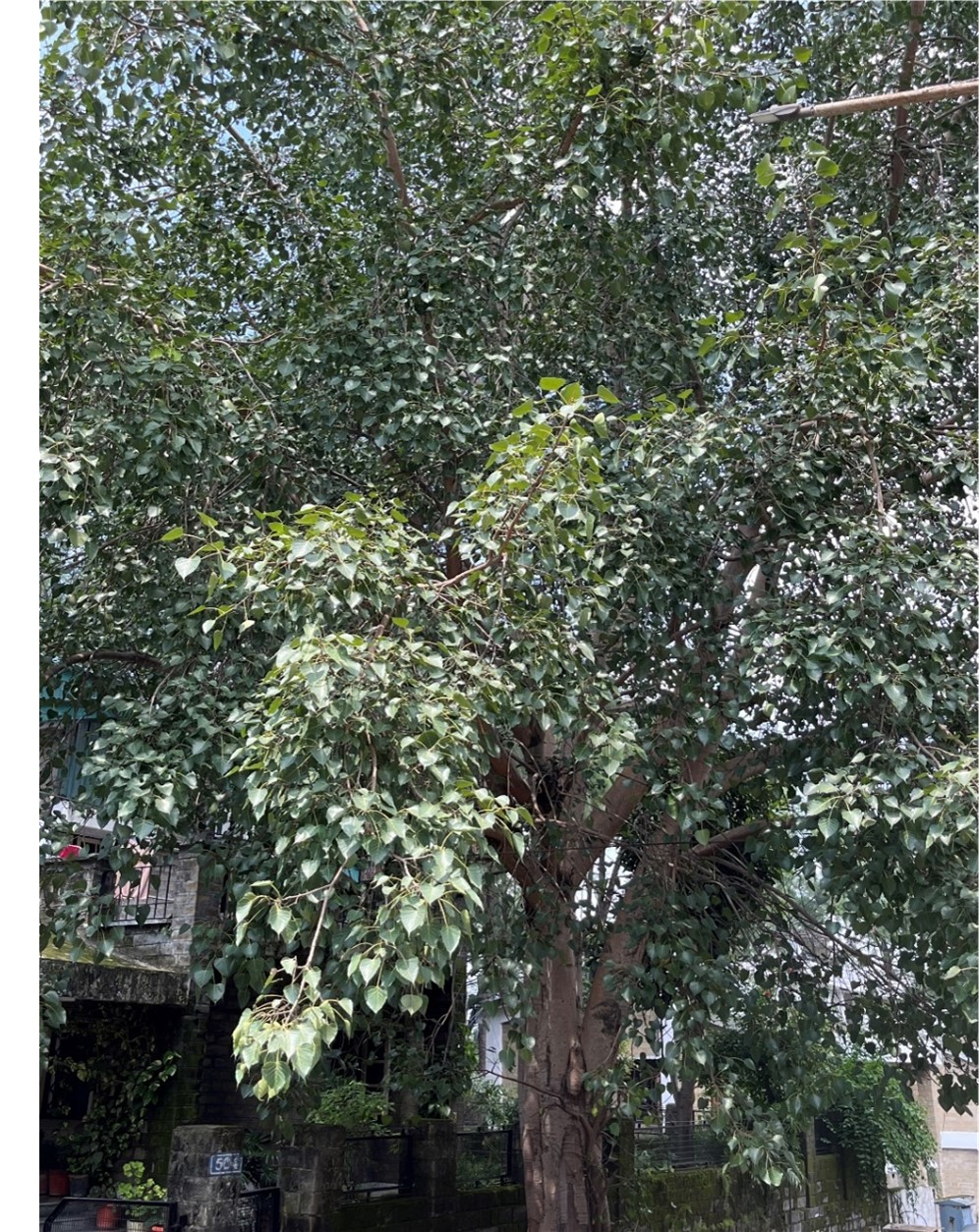Bael and Peepal / Aegle marmelos and Ficus religiosa / Anju Batta Sehgal
Two Sacred Trees of India
Aegle marmelos – Bael
and
Ficus religiosa – Peepal
Dr. Anju Batta Sehgal
Aegle marmelos (L.) Correa ex Roxb. – Bael
Description of the tree
Aegle marmelos is a medium-sized glabrous tree armed with sharp straight axillary thorns, three glabrous, ovate-lanceolate leaflets and greenish-white, sweet scented flowers in short axillary panicles. Its fruits are globose, yellowish and have a woody rind.

Aegle marmelos (photo by the author)
Folk uses
Leaves of the bael (‘bilpatri’) are used in death rituals and are offered to appease Lord Shiva. The leaves have a special religious importance and are used for worshipping Lord Shiva during the entire year but especially during the months of July and August (Saavan). The leaves, three in number (a top leaf with two side leaves), are kept over the sacred deity. Fruit juice is consumed to check constipation. The ripe fruits are edible and considered within Ayurvedic medicine as a skin coolant. The fruit is also used for making ‘murraba’ through preservation in sweet syrup and pickles. The fruit gum is used as an adhesive; its gum in combination with equal quantity of jaggery can be taken twice a day against dysentery. The powdered stem bark with honey is given once daily for asthma and jaundice. The wood is used in ‘hawan’ – religious worshipping.
The reason bael is my favourite
This plant is my favourite because of its medicinal, aesthetic, and religious properties and its sweet fragrance. I like the pickle and sweet fruits put in sweet syrup. I am fascinated when I see the leaves piled over Lord Shiva, especially in the months of July and August. Some studies within India have shown that its powdered leaves taken on empty stomach with luke-warm water for 15 to 30 days can lower blood sugar for people with diabetes. This medicinal property is really the reason bael is my favourite.
Ficus religiosa L. – Peepal
Description of the tree
Ficus religiosa is a large glabrous tree with grey bark having entire, long petiole leaves narrowing to a linear-lanceolate tail. The figs are axillary, in a globular pair, becoming dark purple when ripe.

Ficus religiosa (photo by the author)
Folk uses
Peepal is considered sacred and worshipped. The leaves are used as fodder and increase lactation in animals. A garland of its leaves is hung at the main door of a house during ‘grih-parvesh’ (a house warming ceremony). The wood is used for performing ‘hawan’ ceremonies (religious worship). The tree is worshiped especially on Saturdays by the people who have Saturn planet's influence in their horoscopes. People provide water and mustard oil to the roots of the trees. Earthen pots filled with mustard oil are lit near the tree.
The reason peepal is my favourite
Peepal is my favourite because it is a large tree which adds oxygen to the surroundings, provides shade and fruits and place for tired passengers to rest under its shade. The tree helps people to overcome their fear of Saturn’s effects. The tree is never pruned or cut because of the religious sentiments.
Literature for further reading on bael and peepal
Suggested Books--
Flora of British India - Sir JD Hooker
Flora Simlenesis - Sir Henry Collet
Indian Medicinal Plants (An illustrated Dictionary) - Khare
Medicinal and Aromatic Plants of Himachal Pradesh - Dr. Narain Singh Chauhan
Aegel marmelos
(Ambasta, 1986; Aminuddin & Girach, 1993; Bajpayee & Dixit, 1996; Bhatt et al., 2001; Chowdhury et al., 1996; Datt, 1996; Dwarakan & Ansari, 1996; Goud & Pullaiah, 1996b; Huidrom, 1996; Jain et al., 1994; Jha & Basak, 1994; Kadel & Jain, 2006; Katewa & Arora, 1997; Khare, 2007; Kothari & Moorthy, 1996; Kshirsagar & Singh, 2000; Kurian, 1995; Lalramnghinglova, 1996; Manandhar, 1990; Masih, 2003; Mehrotra et al., 1995; Mishra et al., 1996a; Mohanty et al., 1998; Negi & Gaur, 1991; Painuli & Maheswari, 1996; Patole & Jain, 2002; Pullaiah & Kumar, 1996; Rama Rao & Henry, 1996; Reddy et al., 1998; Retnam & Martin, 2006; Sen & Behera, 2003; Sharma & Singh, 2001; Singh, 2003; Singh & Rao, 2003; Singh et al., 1997; Srivastava et al., 2003; Tirkey et al., 2003a,b; Venkataratnam & Venkata Raju, 2004; Vihari, 1995; Watt, 1972).
Ficus religiosa
(Ambasta, 1986; Bhatt et al., 2001; Borthakur, 1996a; Borthakur et al., 2004; Gogoi & Borthakur, 1991; Gogoi et al., 2003; Hosagoudar & Henry 1996a; Jadhav, 2006; Jain, 1991; Jain et al., 1991; Jha & Basak, 1994; Kalpesh et al., 2004; Khanna, 2002; Khanna & Kumar 2000; Khanna et al., 1996 a, b; Khare, 2007; Kumar & Chauhan, 2006; Kumar & Jain, 1998; Masih, 2003; Mishra et al., 1996a; Pawar & Patil, 2004; Rama Rao & Henry, 1996; Satapathy & Brahmam, 1996; Sikarwar & Kaushik, 1992; Singh & Rao, 2003; Srivastava et al., 2003; Virjee et al., 1984; Watt, 1972).
The uses have been written after taking primary data from the indigenous people.
About the author

The author has a doctoral degree in plant sciences. She has served as a professor for twenty-eight years and worked as an administrator of different government colleges in Himachal Pradesh for almost eight years (Principal/ Director). She is the author of the interesting and important book "Underutilized Plant Resources of The Himalayas." Her academic work has been presented at conferences in the United States, Canada, and India. Dr. Sehgal was recently elected as a council member of the Society for Ethnobotany with its headquarters in St. Louis, Missouri, USA. She is a member of the Society of Ethnobiology USA, and various Indian professional and academic societies including the Association for Phytotaxonomy, Botanical Society of India, Andaman Science Association, and the Association of Biotechnologists of Himachal Pradesh.
The Society for Ethnobotany is open to researchers, practitioners, and enthusiasts of ethnobotany and economic botany.
The 2026 SEB Annual Meeting will take place in Montpellier, France, from May 31-June 4th!
If you have an interest in ethnobotany or economic botany you can become a member of the Society for Ethnobotany.
If you are a member of the Society for Ethnobotany and would like to contribute a Favorite Plant please contact Blair Orr, blairorr@ymail.com. (Note: ymail, not gmail.)
